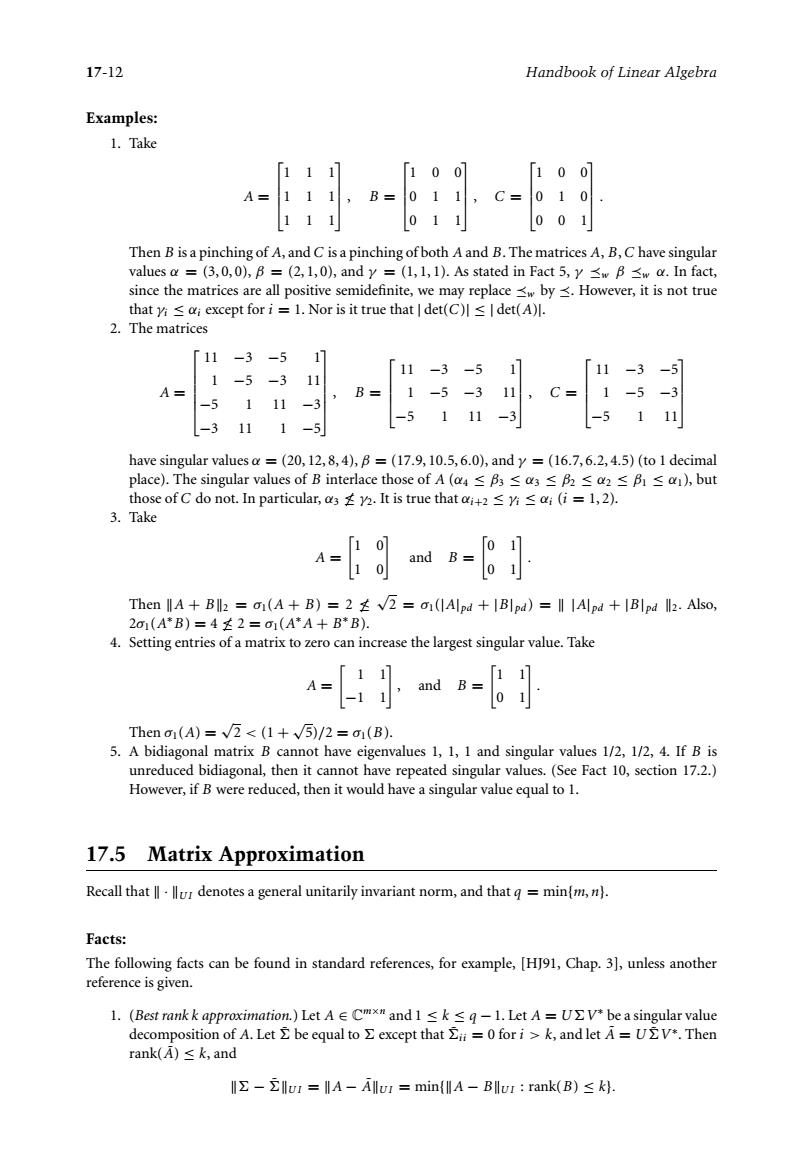正在加载图片...

17-12 Handbook of Linear Algebra Examples: 1.Take 111 011 Then B isa pinching of A,and C isa pinching of both Aand B.The matrices A,B,C have singular values a =(3,0,0),B=(2,1,0),andy=(1,1,1).As stated in Fact 5,yBwa.In fact, since the matrices are all positive semidefinite,we may replace by.However,it is not true thaty<except fori=1.Nor is it true that det(C)det(A). 2.The matrices [11-3-511 「11-3-51] 「11-3-5] A= B=1-5-3,c=1-5-3 -5111 -3111-5 -5111-3 have singular values a =(20.12.8.4).B=(17.9.10.5.6.0).amdy=(16.7.6.2.45)(to1 decima place).The s ngular values of B interlace those of A(a4≤B≤a3≤h≤a2≤A≤a,but those particular.I is truethat+2≤片≤6=l,2 3.Take A-m-B 0寸 Then IlA Bll2 a1(A+B)=2=(1Alpa +Blpa)=ll Alpa +Blpa ll2.Also, 2G1(A*B)=4+2=01(A*A+B*B). 4.Setting entries of a matrix to zero can increase the largest singular value.Take Then ou(A)=√2<(1+√⑤/2=m(B. 5.A bidiagonal matrix B cannot have eigenvalues 1,1,1 and singular values 1/2,1/2,4.If B is unreduced bidiagonal,then it cannot have repeated singular values.(See Fact 10,section 17.2.) However,if B were reduced,then it would have a singular value equal to 1. 17.5 Matrix Approximation Recall denotes a general unitarily invariant norm,and that =min( facts. The following facts can be found in standard references,for example,[H91,Chap.)unless another reference is given. l.(Best rank k approximation.)LetA∈cmxn and 1≤k≤q-l.LetA=U∑V*be a singular value decomposition of A.Let be equal to E except that=0fori>k,and let A=UV*.Then rank(A)≤k,and -=A Allur min(lA-rank(B)sk).17-12 Handbook of Linear Algebra Examples: 1. Take A = ⎡ ⎢ ⎢ ⎣ 111 111 111 ⎤ ⎥ ⎥ ⎦ , B = ⎡ ⎢ ⎢ ⎣ 100 011 011 ⎤ ⎥ ⎥ ⎦ , C = ⎡ ⎢ ⎢ ⎣ 100 010 001 ⎤ ⎥ ⎥ ⎦ . Then B is a pinching of A, and C is a pinching of both A and B. The matrices A, B,C have singular values α = (3, 0, 0), β = (2, 1, 0), and γ = (1, 1, 1). As stated in Fact 5, γ
w β
w α. In fact, since the matrices are all positive semidefinite, we may replace
w by
. However, it is not true that γi ≤ αi except for i = 1. Nor is it true that | det(C)|≤| det(A)|. 2. The matrices A = ⎡ ⎢ ⎢ ⎢ ⎢ ⎣ 11 −3 −5 1 1 −5 −3 11 −5 1 11 −3 −3 11 1 −5 ⎤ ⎥ ⎥ ⎥ ⎥ ⎦ , B = ⎡ ⎢ ⎢ ⎣ 11 −3 −5 1 1 −5 −3 11 −5 1 11 −3 ⎤ ⎥ ⎥ ⎦ , C = ⎡ ⎢ ⎢ ⎣ 11 −3 −5 1 −5 −3 −5 1 11 ⎤ ⎥ ⎥ ⎦ have singular values α = (20, 12, 8, 4), β = (17.9, 10.5, 6.0), and γ = (16.7, 6.2, 4.5) (to 1 decimal place). The singular values of B interlace those of A (α4 ≤ β3 ≤ α3 ≤ β2 ≤ α2 ≤ β1 ≤ α1), but those of C do not. In particular, α3 ≤ γ2. It is true that αi+2 ≤ γi ≤ αi (i = 1, 2). 3. Take A = 1 0 1 0 and B = 0 1 0 1 . Then A + B2 = σ1(A + B) = 2 ≤ √2 = σ1(|A|pd + |B|pd ) =|A|pd + |B|pd 2. Also, 2σ1(A∗B) = 4 ≤ 2 = σ1(A∗A + B∗B). 4. Setting entries of a matrix to zero can increase the largest singular value. Take A = 1 1 −1 1 , and B = 1 1 0 1 . Then σ1(A) = √2 < (1 + √5)/2 = σ1(B). 5. A bidiagonal matrix B cannot have eigenvalues 1, 1, 1 and singular values 1/2, 1/2, 4. If B is unreduced bidiagonal, then it cannot have repeated singular values. (See Fact 10, section 17.2.) However, if B were reduced, then it would have a singular value equal to 1. 17.5 Matrix Approximation Recall that ·U I denotes a general unitarily invariant norm, and that q = min{m, n}. Facts: The following facts can be found in standard references, for example, [HJ91, Chap. 3], unless another reference is given. 1. (Best rank k approximation.) Let A ∈ Cm×n and 1 ≤ k ≤ q −1. Let A = UV∗ be a singular value decomposition of A. Let ˜ be equal to except that ˜ ii = 0 for i > k, and let A˜ = U˜ V∗. Then rank(A˜) ≤ k, and − ˜ U I = A − A˜U I = min{A − BU I : rank(B) ≤ k}.�����������